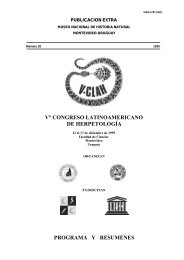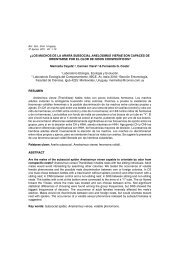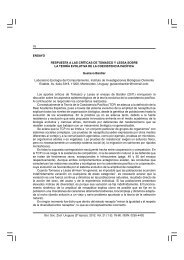Primer Congreso Uruguayo de Zoología - Sociedad Zoológica del ...
Primer Congreso Uruguayo de Zoología - Sociedad Zoológica del ...
Primer Congreso Uruguayo de Zoología - Sociedad Zoológica del ...
Create successful ePaper yourself
Turn your PDF publications into a flip-book with our unique Google optimized e-Paper software.
ROL DE LA COMPLEJIDAD ESPACIAL COMO FUERZA ESTRUCTURADORA DE LACOMUNIDAD DE ZOOPLANCTON EN ARROYOSVidal N. 1 , M. Meerhoff 1,2,3 , F. Teixeira <strong>de</strong> Mello 1,2 , T. Boll 2 ; I. González Bergonzoni 1,2 , M Gerhard 1 , A. .Baattrup-Pe<strong>de</strong>rsen 3 & E. Jeppesen 31 Grupo <strong>de</strong> Ecología y Rehabilitación <strong>de</strong> Sistemas Acuáticos, Departamento <strong>de</strong> Ecología y Evolución, CURE-Facultad <strong>de</strong> Ciencias,Universidad <strong>de</strong> la República. Montevi<strong>de</strong>o, Uruguay. 2 Asociación Investigación y Desarrollo I+D. Montevi<strong>de</strong>o, Uruguay. 3 NationalEnvironmental Research Institute. Aarhus University. Silkeborg, Dinamarca.La complejidad espacial afecta directa e indirectamente a las comunida<strong>de</strong>s acuáticas, a través <strong>de</strong> diferentes vías. Enparticular, se reconoce la importancia <strong>de</strong> las plantas acuáticas como generadoras <strong>de</strong> refugio para el zooplancton enlagos someros. Sin embargo, los arroyos presentan restricciones ambientales bien marcadas (<strong>de</strong>riva) para losorganismos zooplanctónicos, y por lo tanto se espera que dicha comunidad responda positivamente a la presencia <strong>de</strong>microambientes que minimicen el efecto <strong>de</strong> la <strong>de</strong>riva. Por otro lado, en la superficie <strong>de</strong> las plantas acuáticas se<strong>de</strong>sarrolla el perifíton (conglomerado <strong>de</strong> microalgas, bacterias, hongos y <strong>de</strong>tritus), que representa una fuente <strong>de</strong>recurso potencialmente importante para el zooplancton. Este trabajo tiene como objetivo analizarexperimentalmente el uso <strong>de</strong>l espacio <strong>de</strong>l zooplancton en arroyos. Para ello analizamos la distribución <strong>de</strong>lzooplancton en cuatro arroyos <strong>de</strong>l <strong>de</strong>partamento <strong>de</strong> Tacuarembó-Uruguay (Zapucay, California, Carpinterías yTacuarembó Chico), comparando dos tratamientos: plantas acuáticas y aguas abiertas. Los tratamientos con plantasconsistieron en seis parches <strong>de</strong> plantas artificiales (área= 0.28 m2), colocados en un tramo <strong>de</strong> 100 m <strong>de</strong> cada arroyo.Para permitir la colonización por los organismos, las plantas fueron muestreadas luego <strong>de</strong> 15 días <strong>de</strong> su colocación,cuando se tomaron muestras <strong>de</strong> perifiton (concentración <strong>de</strong> clorofila y materia orgánica) y zooplancton (4 L, 55 µmtamaño <strong>de</strong> poro <strong>de</strong>l filtro). Cerca <strong>de</strong> cada parche <strong>de</strong> plantas se tomó una muestra <strong>de</strong> zooplancton en aguas abiertas.Durante el muestreo se midieron parámetros ambientales (velocidad <strong>de</strong> corriente, disponibilidad <strong>de</strong> luz). Comoesperábamos, la comunidad zooplanctónica estuvo fuertemente asociada a las plantas acuáticas. La riqueza <strong>de</strong> taxasfue superior en las plantas para todos los arroyos, mientras que la abundancia <strong>de</strong> organismos también fue superior,excepto en el arroyo Tacuarembó Chico. Se discuten los resultados en relación a los parámetros ambientales, asícomo la disponibilidad <strong>de</strong> recursos <strong>de</strong> cada arroyo.LONG-TERM HISTORICAL CONSIDERATION ABOUT THE CONFLICT BETWEEN RICEPRODUCTION AND FISHERIES IN THE BRAZILIAN SIDE OF MIRIM LAGOONVieira, J. 1 ; Fernan<strong>de</strong>s, L. 2 & T. Basaglia 1 .1 Instituto <strong>de</strong> Oceanografia - FURG. 2 UFPEL. vieira@mikrus.com.br.Lagoa Mirim is a large lagoon, with an area of 3750 km2 inserted in a river basin shared between Brazil (82%) andUruguay (18%). The region\'s economy is based on rice cultivation and livestock, while fishing (about 340 Brazilianfishermen arranged in 5 colonies) is a very important socio-economic activity. The lagoon is connected to Patoslagoon estuary through the São Gonçalo channel and water flows only in the Patos direction as a dam was built in1977 to prevent salt-water intrusion in the system. The dam changed, dramatically, the structure and function of theMirim Lagoon and Canal São Gonçalo, creating a barrier to salt-water and, consequently, for the migration ofestuarine-marine species of economic importance for fishing. This study examines historical monthly data of waterlevel variation (1912 to present), historical records of fishing (1975, 1993 and 1996 to 2005), as well as data of fishpurchased by a local industry (2001 to 2006), and semi-structured interviews with local fishermen. Data analysissuggests that the average level of the lake is rising, although an inter-annual variations of more than 4m is usual.Estuarine species abundance <strong>de</strong>clined drastically, and fishermen suggest also the <strong>de</strong>crease of fresh-water stocks.However, data for dominant species reveal strong inter-annual variations that could not be correlated with waterlevel, suggesting that the interests of the local rice industries, livestock and fishermen are not usually coordinatedwith each other, creating conflicts of interest that may affect the sustainability of this rich coastal ecosystem. We alsoreported the invasion of the gol<strong>de</strong>n mussel Limnoperna fortunei and the La Plata croaker Pachyurus bonariensis, twoalien species that recently established successful populations in the Mirim Lagoon and should bring strong trophicand structural consequences to the system.132 <strong>Primer</strong> <strong>Congreso</strong> <strong>Uruguayo</strong> <strong>de</strong> <strong>Zoología</strong>







